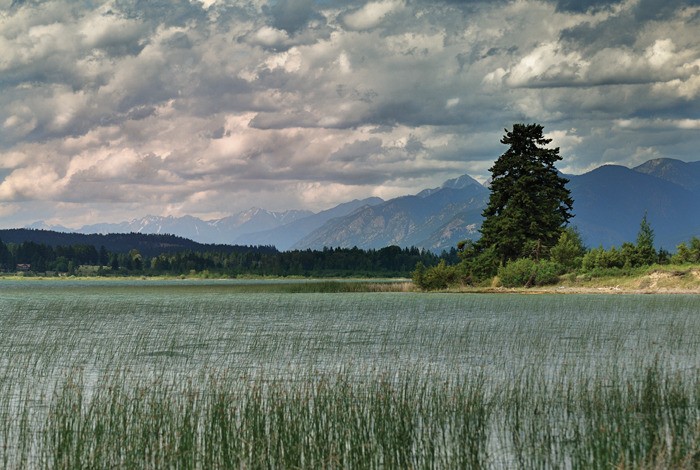Lot 48 has finally been protected thanks to the dedicated efforts of the Nature Conservancy of Canada (NCC) and a large number of organizations and individuals.
“It’s a huge thrill,” said Nancy Newhouse, Canadian Rockies program manager for the NCC. “It’s been a project that so many people have been involved with to try and find a solution for so many years, and it’s great to see it come to fruition.”
After years of fundraising, the NCC announced in a June 11 release that they had successfully raised the $7.2 million required to secure the ecologically and culturally sensitive property and create a stewardship endowment. This brings to a close over seven years of uncertainty, beginning in 2005 when the private owners of the lot brought forward plans to build a golf resort on the land.
“This has been a really long road to get to this point,” said Wendy Booth, Regional District of East Kootenay (RDEK) director for Area F, which Lot 48 falls within. “So many people have come together and worked so hard on pulling this together… there were days where I thought for sure it was going to happen, and days where I thought for sure it’s not going to happen.
“It’s just one of those things, you never know until the deadline.”
As of May 7, the NCC was making its final push to secure the last $366,000 needed to meet the asking price and were turning to individuals, organizations and businesses alike, looking for last minute donations ahead of the June 1 deadline.
A large number of individuals and groups had already contributed, but as Wildsight Director Ellen Zimmerman points out, local communities still played a massive role in the final fundraising efforts.
“The part I really want to acknowledge is the part that the community played,” she said. “So many residents that live in the area understood how important it is that the east side (of Columbia Lake) stay protected. Just to see that this area will be protected is a great triumph for the environment.”
“The final funds came in from a variety of sources, and the community really stepped up to the plate,” confirmed Newhouse.
Lot 48, located about 5 kilometres south of Fairmont Hot Springs, is surrounded by a provincial park and a wildlife management area, and has long been viewed as the final piece of the puzzle to creating an uninterrupted conservation area on the east side of Columbia Lake. Although the lot itself is only about 300 acres, protecting the lot means that there is now an 18,000 acre conservation area, something Ktunaxa Nation Chair Kathryn Teneese feels is essential.
“I think it’s very important, because in the entirety of our territory there is all kinds of development taking place, and we want to ensure that future generations are afforded the opportunity to appreciate areas the same way that we and past generations have been able to,” she said. “I think it’s really important that we think sort of beyond today and make sure that we’re protecting for tomorrow.”
Teneese has a particular interest in Lot 48 because of the aforementioned cultural significance. For thousands of years, the Ktunaxa used the area as a transportation route and to this day archaeological evidence of this route remains, including pictographs and burial sites.
“We certainly were hopeful that it was all going to come together,” said Teneese. “The concept of protection for various purposes is one that we all should be embracing.”
Aside from the cultural significance of the land, it also serves an important ecological role. Animals such as elk, bighorn sheep, badgers, grizzly bears, black bears, cougars and bobcats have all been known to use the area as habitat, and one of the first steps for the NCC now that the land is secure is to catalogue exactly which animals and plants call the land home.
Teneese is also hopeful that the Ktunaxa can be involved in joint management discussions, while Booth is unsure what role the RDEK will play in future management decisions. Regardless, all the parties involved are extremely happy that Lot 48 is now protected and would like to send a warm thank you to all the people and organizations that contributed.
“It’s a wonderful position to be in, and it’s such a great example of partnership,” said Newhouse. “I don’t think we’ve ever done a project that’s involved so many different partners from such a broad spectrum.”
pictographs and burial sites.
“We certainly were hopeful that it was all going to come together,” said Teneese. “The concept of protection for various purposes is one that we all should be embracing.”
Aside from the cultural significance of the land, it also serves an important ecological role. Animals such as elk, bighorn sheep, badgers, grizzly bears, black bears, cougars and bobcats have all been known to use the area as habitat, and one of the first steps for the NCC now that the land is secure is to catalogue exactly which animals and plants call the land home.
Teneese is also hopeful that the Ktunaxa can be involved in joint management discussions, while Booth is unsure what role the RDEK will play in future management decisions. Regardless, all the parties involved are extremely happy that Lot 48 is now protected and would like to send a warm thank you to all the people and organizations that contributed.
“It’s a wonderful position to be in, and it’s such a great example of partnership,” said Newhouse. “I don’t think we’ve ever done a project that’s involved so many different partners from such a broad spectrum.”
